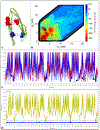Thermodynamics and Free Energy Landscape of BAR-Domain Dimerization from Molecular Simulations
- PMID: 33826319
- PMCID: PMC8224822
- DOI: 10.1021/acs.jpcb.0c10992
Thermodynamics and Free Energy Landscape of BAR-Domain Dimerization from Molecular Simulations
Abstract
Proteins with BAR domains function to bind to and remodel biological membranes, where the dimerization of BAR domains is a key step in this function. These domains can dimerize in solution or after localizing to the membrane surface. Here, we characterize the binding thermodynamics of homodimerization between the LSP1 BAR domain proteins in solution, using molecular dynamics (MD) simulations. By combining the MARTINI coarse-grained protein models with enhanced sampling through metadynamics, we construct a two-dimensional free energy surface quantifying the bound versus unbound ensembles as a function of two distance variables. With this methodology, our simulations can simultaneously characterize the structures and relative stabilities of a range of sampled dimers, portraying a heterogeneous and extraordinarily stable bound ensemble, where the proper crystal structure dimer is the most stable in a 100 mM NaCl solution. Nonspecific dimers that are sampled involve contacts that are consistent with experimental structures of higher-order oligomers formed by the LSP1 BAR domain. Because the BAR dimers and oligomers can assemble on membranes, we characterize the relative alignment of the known membrane binding patches, finding that only the specific dimer is aligned to form strong interactions with the membrane. Hence, we would predict a strong selection of the specific dimer in binding to or assembling when on the membrane. Establishing the pairwise stabilities of homodimer contacts is difficult experimentally when the proteins form stable oligomers, but through the method used here, we can isolate these contacts, providing a foundation to study the same interactions on the membrane.
Conflict of interest statement
The authors declare no competing financial interest.
Figures








Similar articles
-
Membrane transporter dimerization driven by differential lipid solvation energetics of dissociated and associated states.Elife. 2021 Apr 7;10:e63288. doi: 10.7554/eLife.63288. Elife. 2021. PMID: 33825681 Free PMC article.
-
On Computing Equilibrium Binding Constants for Protein-Protein Association in Membranes.J Chem Theory Comput. 2022 Jun 14;18(6):3961-3971. doi: 10.1021/acs.jctc.2c00106. Epub 2022 May 17. J Chem Theory Comput. 2022. PMID: 35580264 Free PMC article.
-
Membrane sculpting by F-BAR domains studied by molecular dynamics simulations.PLoS Comput Biol. 2013;9(1):e1002892. doi: 10.1371/journal.pcbi.1002892. Epub 2013 Jan 31. PLoS Comput Biol. 2013. PMID: 23382665 Free PMC article.
-
Evaluating the Efficiency of the Martini Force Field to Study Protein Dimerization in Aqueous and Membrane Environments.J Chem Theory Comput. 2021 May 11;17(5):3088-3102. doi: 10.1021/acs.jctc.0c00507. Epub 2021 Apr 29. J Chem Theory Comput. 2021. PMID: 33913726
-
BAR domains and membrane curvature: bringing your curves to the BAR.Biochem Soc Symp. 2005;(72):223-31. doi: 10.1042/bss0720223. Biochem Soc Symp. 2005. PMID: 15649145 Review.
Cited by
-
A Review of Mechanics-Based Mesoscopic Membrane Remodeling Methods: Capturing Both the Physics and the Chemical Diversity.J Membr Biol. 2022 Dec;255(6):757-777. doi: 10.1007/s00232-022-00268-4. Epub 2022 Oct 5. J Membr Biol. 2022. PMID: 36197492 Review.
-
Role of the dynamin-related protein 2 family and SH3P2 in clathrin-mediated endocytosis in Arabidopsis thaliana.J Cell Sci. 2024 Apr 15;137(8):jcs261720. doi: 10.1242/jcs.261720. Epub 2024 May 2. J Cell Sci. 2024. PMID: 38506228 Free PMC article.
-
Flexible Gaussian Accelerated Molecular Dynamics to Enhance Biological Sampling.J Chem Theory Comput. 2023 Sep 26;19(18):6521-6531. doi: 10.1021/acs.jctc.3c00619. Epub 2023 Aug 30. J Chem Theory Comput. 2023. PMID: 37649349 Free PMC article.
-
Binding affinities for 2D protein dimerization benefit from enthalpic stabilization.bioRxiv [Preprint]. 2025 Mar 15:2025.01.16.633485. doi: 10.1101/2025.01.16.633485. bioRxiv. 2025. PMID: 40161697 Free PMC article. Preprint.
-
Unfolding Mechanisms and Conformational Stability of the Dimeric Endophilin N-BAR Domain.ACS Omega. 2021 Aug 4;6(32):20790-20803. doi: 10.1021/acsomega.1c01905. eCollection 2021 Aug 17. ACS Omega. 2021. PMID: 34423187 Free PMC article.
References
-
- Simunovic M; Evergren E; Callan-Jones A; Bassereau P Curving Cells Inside and Out: Roles of BAR Domain Proteins in Membrane Shaping and Its Cellular Implications. Annu. Rev. Cell Dev. Biol 2019, 35, 111–129. - PubMed
-
- McMahon HT; Boucrot E Molecular mechanism and physiological functions of clathrin-mediated endocytosis. Nat. Rev. Mol. Cell Biol 2011, 12, 517–533. - PubMed
-
- Ziółkowska NE; Karotki L; Rehman M; Huiskonen JT; Walther TC Eisosome-driven plasma membrane organization is mediated by BAR domains. Nat. Struct. Mol. Biol 2011, 18, 854–856. - PubMed
-
- Nicot AS; et al. Mutations in amphiphysin 2 (BIN1) disrupt interaction with dynamin 2 and cause autosomal recessive centronuclear myopathy. Nat. Genet 2007, 39, 1134–1139. - PubMed
-
- Masuda M; Mochizuki N Structural characteristics of BAR domain superfamily to sculpt the membrane. Semin. Cell Dev. Biol 2010, 21, 391–398. - PubMed
Publication types
MeSH terms
Substances
Grants and funding
LinkOut - more resources
Full Text Sources
Other Literature Sources
Miscellaneous

